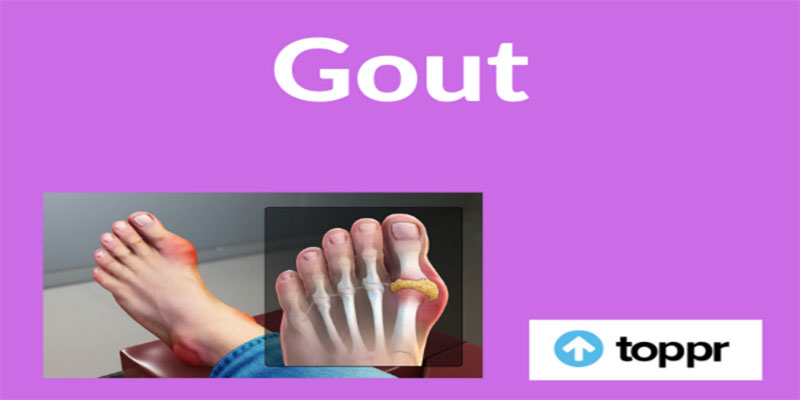What Are the Triggers for Gout Pain? Gout is considered arthritis by medical professionals, who use the word to describe a wide variety of conditions that cause pain and inflammation in the joints. However, joint inflammation is a common symptom of arthritis, and not all types of the disease share this characteristic. Many people suffer from gout, a variety of autoimmune diseases. Crystals of uric acid cause the problem. Joint pain and swelling are common symptoms of gout. The big toe is the usual target of this condition. However, it is not limited to only the knee; it is also present throughout the ankle, foot, hands, wrist, and elbow.
Typical Causes Of Gout Flares
The accumulation of uric acid in the joints leads to a painful condition known as gout. Purines may be present in the body and certain foods; uric acid is produced when these purines are broken down. Commonly, uric acid is eliminated by the urinary system. Gout attacks occur whenever excess uric acid forms catheter crystals throughout the joints and is not destroyed. Certain items are well-known to bring on an episode of gout. Knowing the triggers may help you avoid or lessen gout attacks. Thus it's crucial to do so if you want to prevent or alleviate the discomfort associated with this condition.
Certain Types Of Meat And Seafood
The chance of experiencing a gout attack is increased when one consumes meals high in purines. These are some examples of high-purine foods:
- Meats from the ruminant species (beef, lamb, and pig)
- The kidney and liver are examples of organ meat.
- Many types of seafood
- Anchovies
- Sardines
- Trout
- TunaMussels
Scallops
However, it does not seem that eating any purine-rich meal would increase your concentration of uric acid and otherwise gout risk. Vegetables high in purine but not associated with an increased risk of gout include peas, beans, lentils, spinach, asparagus, and mushrooms.
Alcohol

Uric acid concentrations in the blood rise after consuming alcoholic beverages such as beer, wine, and liquor. Gout attacks are more likely due to more and more drinking. However, one research indicated that, indeed, alcohol in moderation use might raise the incidence of a gout attack in males. The risk of something like a gout flare was 36% greater among men who drank a maximum of two drinks in 24 hours than those who drank no alcohol during that time. A single alcoholic beverage consumed during 24 hours did not substantially raise the risk. Flares might be avoided by cutting down overall alcohol consumption.
Food And Drinks With A Lot Of Fructose
Only fructose, a specific form of sugar, is associated with increased amounts of uric acid produced by the body. Fruit juices and sugary soft drinks are two examples of fructose-rich beverages that have been demonstrated to raise uric acid levels in the blood. Increased incidence of gout attacks has also been related to eating foods rich in fructose, such as cookies and candies. You might lessen your chance of experiencing a gout attack by avoiding or restricting your consumption of these high-sugar beverages and foods.
Increased Body Mass Index
Gout is more likely to occur in those who are overweight or obese. High amounts of uric acid have been linked to increased levels of obesity. 5 Even if you already have gout, this link may still affect your condition. Losing weight via food and physical activity may help reduce uric acid levels and stave off future flares if you fall into the overweight or obese BMI category.
The Unexpected Causes Of Gout
Other gout triggers should be examined in addition to the well-known ones, such as particular foods, beverages, and lifestyle variables.
Stress
There is still work to be done to establish the specific link. However, studies have shown that stress may raise uric acid levels throughout the body. According to the literature, those suffering from gout should try to avoid stressful situations or take measures to lessen their stress levels.
Aspirin

The chance of a gout attack may be roughly doubled by taking low doses of aspirin, which can raise purine levels in the bloodstream. After two days of using low-dose aspirin, the likelihood of a gout attack rises, according to one research. When the dosage is modest, the correlation increases. However, aspirin taken at a tolerable dosage is often used to keep the heart healthy.
Dehydration
When you're dehydrated, you may not urinate as often, which means more uric acid builds up in your system. People with gout should consume large amounts of water daily to reduce their chances of a gout episode. Water intake should be increased when exercising rather than spending time in hotter conditions like a sauna.
Conclusion
Gout is considered arthritis by medical professionals, who use the word to describe a wide variety of conditions that cause pain and inflammation in the joints. However, joint inflammation is a common symptom of arthritis, and not all types of the disease share this characteristic. Many people suffer from gout, some autoimmune disease. Crystals of uric acid cause the problem. Joint pain and swelling are common symptoms of gout. The big toe is the usual target of this condition. However, it is not limited to only the knee; it is also present inside the ankle, foot, palm, wrist, and even elbow.




